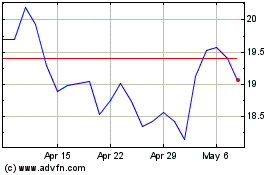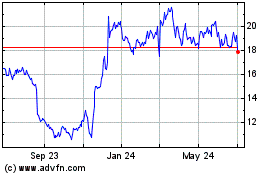By Suzanne Kapner and Sarah Nassauer
So much for the retail apocalypse.
Buoyed by rising wages and employment as well as tax cuts,
Americans are spending more on everything from jeans and handbags
to wall paint. That has translated to rising sales at chains
ranging from Walmart Inc. to Home Depot Inc. to Coach owner
Tapestry Inc., which each reported stronger results this week.
On Thursday, Walmart said its quarterly sales rose at the
fastest rate in over a decade as the world's largest retailer
continues to draw more people to stores and benefit from shoppers
having more disposable income.
"Customers tell us that they feel better about the current
health of the U.S. economy as well as their personal finances,"
Walmart Chief Executive Doug McMillon told investors Thursday.
"They're more confident about their employment opportunities."
Walmart, which gets more than half of its U.S. revenue from
groceries and staples, often tracks its home economy. Gross
domestic product -- the value of all goods and services produced
across the U.S. -- rose 4.1% in the second quarter, the fastest
pace in nearly four years.
"The retail apocalypse that everyone had been talking about
really hasn't happened," said Eric Rosenthal, a senior director of
leveraged finance at Fitch Ratings.
Walmart, which booked $128 billion in global quarterly revenue,
has drawn more shoppers to its supercenters as it remodels stores
and lowers prices. It also reported a 40% jump in U.S. e-commerce
sales. Though e-commerce is a sliver of its business, the growth
showed the company's heavy investments are helping the chain hold
its ground against Amazon.com Inc.
Walmart shares surged about 10% in Thursday morning trading,
giving a boost to the entire retail sector. While Walmart's shares
have lagged behind, many retail stocks have surged this year as
sales have stabilized and investors' fears have eased.
That's not to say traditional retailers aren't still facing
challenges from Amazon, whose rapid growth and discounting has
squeezed industry profits. Analysts also caution potential tariffs
could force retailers to raise prices and eventually crimp demand.
The key test of the industry's health -- and shoppers' appetite to
spend -- has yet to come: The holiday quarter drives the lion's
share of the retail business.
The improving economy isn't lifting everyone. J.C. Penney Co. on
Thursday said its sales fell and its loss doubled to $101 million
in the second quarter. The chain, which is searching for a CEO,
also lowered its forecasts for the year. Its shares plunged 26% in
morning trading to $1.75.
Retailers that have pulled out of the slump have had a sharp
focus on their core customers and invested in serving them better
by plowing money both into their physical stores and online
operations. They have gotten smarter about how they manage their
inventory, leaving them with fewer surplus goods and markdowns at
the end of a season. And they have secured more exclusive brands
that can't be found elsewhere.
Investors can be punishing when retailers show even the
slightest sign of weakness. Macy's Inc. shares fell 16% on
Wednesday, after the chain reported that same-store sales rose just
0.5%. The small gain was due to the shift of a promotional event to
the first quarter, and the chain's profit jumped 50%.
Troubled retailers continue to close locations at a rapid pace.
More than 11,360 U.S. stores have shut since the beginning of 2017,
roughly double the number of openings, according to Coresight
Research.
And a steady parade of chains have filed for bankruptcy this
year, including Toys 'R' Us Inc., regional department-store Bon-Ton
and teen chain Claire's.
Those moves weeded out weaker players and cleared out some of
the overcapacity that has plagued the industry. As a result, the
remaining chains are on more solid footing and are getting a boost
from a stronger economy, analysts say.
Heading into the critical Christmas holidays, the National
Retail Federation raised its 2018 sales forecast to a minimum of
4.5% growth compared with last year. Previously, the trade group
had expected sales to increase 3.8% to 4.4%.
As shoppers tightened their purse strings in recent years, one
of the biggest categories to take a hit was apparel. But that trend
is reversing, with apparel sales up 5.2% from January through July,
compared with the same period a year earlier, on track to have its
best year since 2011, according to Craig Johnson, president of the
consulting firm Customer Growth Partners.
"The single biggest driver for retail growth is growth in
disposable income, and disposable income is much stronger than it
was five years ago," Mr. Johnson said.
Joanne Charles, of Valley Stream, N.Y., said she is spending the
extra money in her paycheck from the tax cuts. The 50-year-old
event planner said she recently bought four dresses at Macy's and
is splurging on makeup and other nonnecessities.
On Wednesday, Ms. Charles browsed the Macy's in Manhattan with
her daughter Jonelle Carrera, who was shopping for clothes for a
new job at a nonprofit that she starts next week. The 30-year-old
Ms. Carrera said that when she graduated from college in 2010, "it
was hard to find a job, but there are more positions posted
today."
Some of that extra spending has been fueled by borrowing, which
has pushed household debt to record highs, according to Beth Ann
Bovino, chief U.S. economist at S&P Global Ratings. But Ms.
Bovino said that when taken as a percentage of disposable income,
household debt is the lowest it has been since the recessionary
peak.
"I feel great about the economy," said Sally Wiggins, of New
City, N.Y. While the 57-year-old, who works in hotel sales, said
she is buying more clothes and shoes for her three college-aged
children, her biggest purchase has been a home on the Gulf Coast
that she and her husband are using as a vacation rental. She said
the property has been booked all summer, "so other people must be
feeling good about the economy too."
Write to Suzanne Kapner at Suzanne.Kapner@wsj.com and Sarah
Nassauer at sarah.nassauer@wsj.com
(END) Dow Jones Newswires
August 16, 2018 11:54 ET (15:54 GMT)
Copyright (c) 2018 Dow Jones & Company, Inc.
Macys (NYSE:M)
Historical Stock Chart
From Mar 2024 to Apr 2024

Macys (NYSE:M)
Historical Stock Chart
From Apr 2023 to Apr 2024
